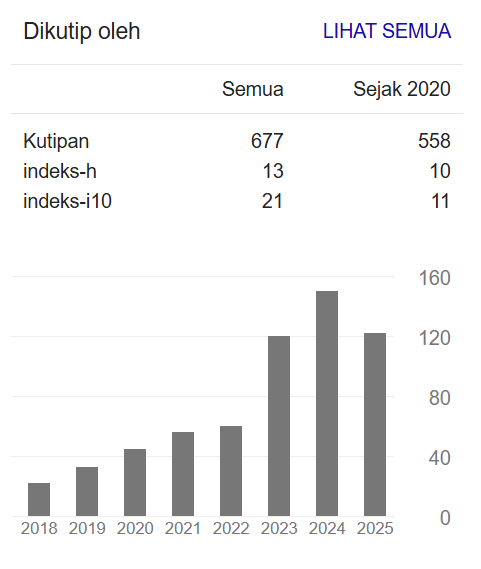FILSAFAT FILM
HAKIKAT GAMBAR DALAM FILM MENURUT GILLES DELEUEZE
DOI:
https://doi.org/10.20871/kpjipm.v8i2.212Keywords:
Film, Gilles Deleuze, Image, Philosophy, SpiritualityAbstract
The purpose of this article is to discuss the nature of images in films according to Gilles Deleuze. Film according to Deleuze consists of images and motion. Image and motion are related and complementary. When humans watch a film, the human mind through the five senses perceives a series of moving images. The finding of this article is that Deleuze views films from ontological and spiritual dimensions. The ontological dimension of film philosophy is that images that move and have duration in the film are real everyday life so that there is no distance between the audience and what is being watched in the film. The ontological aspect of Deleuze's film philosophy is continuous becoming and the essence that precedes existence. While the spiritual dimension in film is an image that moves continuously which is an expression of the senses and human reason. These moving images have a soul or spirit that makes the audience drift into a film's life story. This study uses an analytical descriptive approach. By using analytical descriptive it is produced that the picture in the film is an artificial existence of human life. The existence of imitation human life in films becomes independent from the existence of human life in external reality because it has a different time and the duration has been determined by the humans themselves.
Downloads
References
Azisi, Ali Mursyid. 2020. “Maurice Merleau-Ponty and The Results of His Thoughts.” JURNAL YAQZHAN: Analisis Filsafat, Agama dan Kemanusiaan 6 (2): 187–201. https://doi.org/10.24235/jy.v6i2.7153.
Bogue, Ronald. 2003, Deleuze on Cinema. London & New York: Routledge.
Bouaniche, Arnaud. 2007. Gilles Deleuze: une Introduction. Paris: Agora.
Colebrook, Claire. 2002. Gilles Deleuze. New York: Routledge.
Colman, Felicity. 2011. Deleuze & Cinema: The Film Concepts. New York: Berg.
Deleuze, Gilles, dan Felix Guattari. 1987. A Thousand Plateaus Capitalism and Schizophrenia. Diterjemahkan oleh Brian Massumi. USA: University of Minnesota Press.
———. 2004. What is Philosophy?: Reinterpretasi atas Filsafat, Sains dan Seni. Diterjemahkan oleh Muh. Indra Purnama. Yogyakarta: Jalasutra.
Deleuze, Gilles. 2005. Cinema 1: The Movement-Image. Diterjemahkan oleh Hugh Tomlinson & Barbara Habberjam. London & New York: Continuum International Publishing Group Ltd.
Hasan, Fuad. 2001. Pengantar Filsafat Barat. Jakarta : PT Dunia Pustaka Jaya.
Mabruri, Anton. 2013. Manajemen Produksi Program Acara TV. Jakarta: Gramedia Widiasarana.
Pisters, Patricia. 2003. The Matrix of Visual Culture. Stanford: Stanford University Press.
Priyanggono, Nayoko Bagus, dan Setya Yuwana. 2022. “Subjektivitas Tokoh Utama dalam Film Get Out Karya Jordan Peele: Kajian Teori Subjek Slavoj Zizek.” SAPALA 9 (1): 87—97. https://ejournal.unesa.ac.id/index.php/jurnal-sapala/article/view/45216.
Rodowick, David Norman. 2010. “The World, Time.” Dalam Afterimages of Gilles Deleuze’s Film Philosophy, disunting oleh David Norman Rodowick. Minneapolis: University of Minnesota Press.
Sugiharto, Bambang. 2013. Untuk Apa Seni?. Bandung: Matahari.
Suraiyo, Suraiyo. 2013. Filsafat Ilmu Perkembangannya di Indonesia Suatu Pengantar. Jakarta: Bumi Aksara.
Susanto, Susanto. 1982. Komunikasi Massa 2. Bandung: Bina Cipta,.
Tambunan, Sihol Farida. 2016. “Kebebasan Individu Manusia Abad Dua Puluh: Filsafat Eksistensialisme Sartre.” Jurnal Masyarakat dan Budaya 18 (2): 59—76. https://doi.org/10.14203/jmb.v18i2.412.
Wattimena, Reza A. A. 2011. “Slavoj Žižek tentang Manusia sebagai Subjek Dialektis.” Jurnal Orientasi Baru 20 (1): 61—84. https://e-journal.usd.ac.id/index.php/job/article/view/1274.
Wibowo, Panji. 2002. “Gerak-Waktu-Imaji: Gilles Deleuze dalam Sinema.” Driyarkara TH. XXV (3): 65—74.
Wibowo, Philipus Nugroho Hari, dan Surya Farid Sathotho. 2021. “The Imaginary Lacan Sebagai Inspirasi Penciptaan Skenario Film Pendek Sekuel Kedua Film Koper Gendis Mencari Jawab Menakar Tanya.” TONIL: Jurnal Kajian Sastra, Teater dan Sinema 18 (1): 1—7. https://doi.org/10.24821/tnl.v18i1.4446.
Downloads
Published
How to Cite
Issue
Section
License
Copyright (c) 2022 Kanz Philosophia A Journal for Islamic Philosophy and Mysticism

This work is licensed under a Creative Commons Attribution-NonCommercial-ShareAlike 4.0 International License.





























